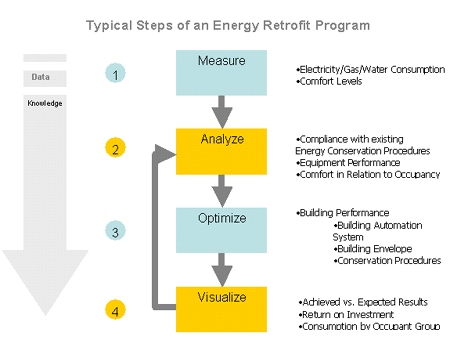| 2.15.08 | Rainer Wischinski, Vice President, Marketing, Spinwave Systems, Inc. |
Whether …
* You are responsible for facility management of a high-rise office or
apartment building and are faced with rising energy bills and
inconsistencies in tenants energy usage;
* You are in charge of energy management of a campus or industrial facility
but without accountability for energy usage there is little incentive for
users to conserve energy;
* You don't know if your recent energy retrofit is really paying off;
* You are charged with making your building(s) more energy-efficient but
don't know where the best return on investment is;
… you probably know that energy savings on the order of 15% can be achieved
when individual metering is in place but you are concerned about equipment
and installation costs and disruption to the building’s operation.
Fortunately, with recent availability of low-cost wireless sensing
solutions, it is easy and affordable to install wirelessly networked
metering solutions which make tenants or departments accountable for usage
without disturbing building occupants.
Sub-metering
Sub-metering is defined as individual tenant billing by utilities
(electricity, gas and water.) In most high-rise office and apartment
buildings, utility use is monitored and billed for the entire building.
Tenants are billed for the utility use on a per square foot basis as part of
the rent or as a proportion of the common costs. This billing procedure does
not encourage tenants to be more efficient in their energy use since they
are not billed directly for usage.
Individual metering of each tenant space overcomes this problem. Individual
metering removes utility costs from common building costs and reduces the
risk to the building owner of non-payment by the tenant. Individual metering
that removes utility costs from the standard rent will also make the
property appear more competitive in the market place.
For the tenant, utility costs are charged on a more equitable basis; this is
particularly important in mixed use/function buildings where energy usage of
one or more tenants varies from the rest.
The ability to wirelessly transmit individual meter readings and make them
available at a central location, accessible through the intranet or
internet, makes sub-metering a cost-effective solution for building owners
trying to manage utility costs and making their space more attractive to
tenants.
Cost Allocation and Accountability
Campus and industrial facilities are often metered centrally with no
information to allocate the utility costs to departments, functions or
manufactured products. Furthermore, meter reading is a tedious manual
process and therefore not performed frequently.
For managers of campus facilities such as colleges, it is very difficult to
come up with a reasonable method of allocation to buildings or departments.
Since there is no accountability for energy usage, there is no feedback and
incentive for users to manage energy wisely.
Similarly, managers of industrial facilities have no way to accurately
assign energy costs to product lines which limits the ability of the company
to determine the profitability of specific products or functions.
Most building owners and facility managers have established procedures
(e.g., turning off lights, temperature setbacks) to minimize the waste of
energy in their facilities. In most cases, it is difficult to determine
whether procedures are being followed or whether faulty equipment is
resulting in increased energy usage.
Using wireless pulse counter devices for electricity, gas, and water and
centrally consolidated meter data, facility managers can easily assign
utility costs to users within the organization and provide accountability
for that usage. Wireless metering provides cost effective installation with
plug-and-play connectivity without the need to install additional
communication lines. Often existing meters can be cost-effectively
retrofitted with “pulsers,” allowing them to be easily interfaced to
wireless pulse counter modules.
Pitfalls in Energy Management Programs
The first step in any energy management program, usually yielding the best
return on investment, is a program to sub-meter energy usage and monitor
environmental conditions (e.g. temperature, humidity, air quality) to
provide a clear picture of comfort levels, where energy is being used, where
energy can be saved and whether existing energy conservation procedures are
being followed.
ROI Analysis – Staying on Track
A good portion of energy retrofit projects either never achieve the
projected pay-backs or fail to sustain initial savings due to ineffective
means of monitoring and verifying energy savings.

Solution
In the past, the cost of monitoring and verification were cost prohibitive
and many projects have been implemented without adequate monitoring
technology in place, resulting in lower return on investment.
Effective measurement and verification of energy usage and indoor comfort
levels not only ensures that installation and commissioning are done
correctly, but also provides continuous feedback on the long term success of
the energy retrofit while ensuring a comfortable and healthy environment for
building occupants.
A wide range of automated metering options:
All-in-one PC-based solution: There are wireless mesh network solutions
available that make meter readings and sensor data wirelessly available to
Monitoring Software running on a PC.
The Monitoring Software can notify energy managers and facility managers as
soon as a value drifts out the acceptable range and can make historical
current demand and comfort data available for analysis.
Other solutions provide integration capabilities with an existing Building
Automation System, allowing to provide data to virtually any building
automation system, PLC or SCADA software through open protocols, like LON,
BACnet, Modbus or even direct I/O interfaces. Wireless metering data can be
used for sub-metering reports and for load shedding strategies.
The Bottom Line: Wireless sensor networks provide a non-intrusive,
easy-to-install and cost-effective solution for reducing utility costs
through accountability metering.
![]()
Copyright © 2002-2006, CyberTech, Inc. - All rights reserved.